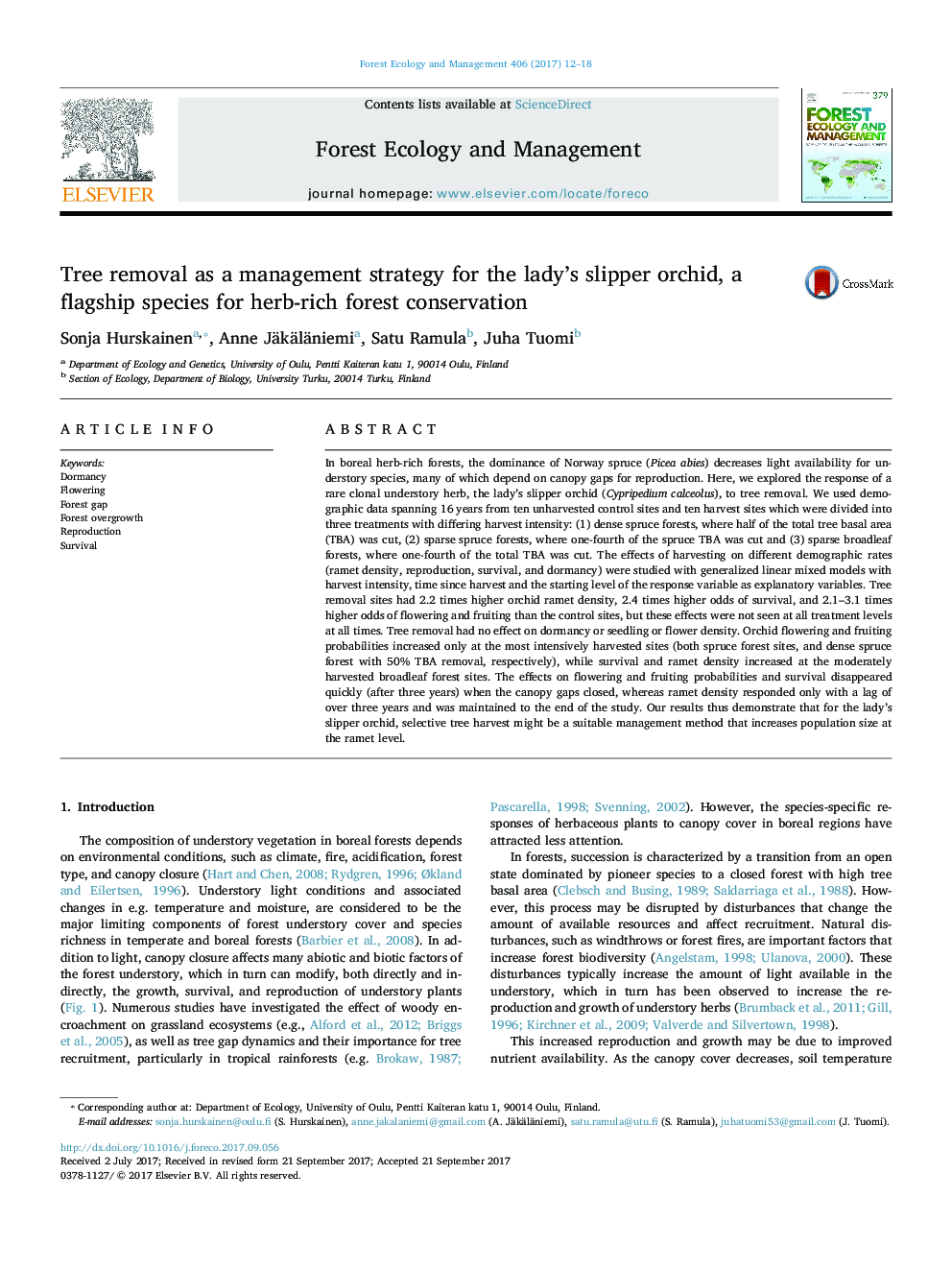| کد مقاله | کد نشریه | سال انتشار | مقاله انگلیسی | نسخه تمام متن |
|---|---|---|---|---|
| 6542002 | 1421352 | 2017 | 7 صفحه PDF | دانلود رایگان |
عنوان انگلیسی مقاله ISI
Tree removal as a management strategy for the lady's slipper orchid, a flagship species for herb-rich forest conservation
ترجمه فارسی عنوان
حذف درخت به عنوان یک استراتژی مدیریت برای ارغوانی دمپایی خانم، یک گونه گل سرسبد برای حفاظت از جنگل های غنی گیاهی
دانلود مقاله + سفارش ترجمه
دانلود مقاله ISI انگلیسی
رایگان برای ایرانیان
کلمات کلیدی
دورمنس، گل زدن، شکاف جنگل، رشد بیش از حد جنگل، تولید مثل، بقا،
موضوعات مرتبط
علوم زیستی و بیوفناوری
علوم کشاورزی و بیولوژیک
بوم شناسی، تکامل، رفتار و سامانه شناسی
چکیده انگلیسی
In boreal herb-rich forests, the dominance of Norway spruce (Picea abies) decreases light availability for understory species, many of which depend on canopy gaps for reproduction. Here, we explored the response of a rare clonal understory herb, the lady's slipper orchid (Cypripedium calceolus), to tree removal. We used demographic data spanning 16Â years from ten unharvested control sites and ten harvest sites which were divided into three treatments with differing harvest intensity: (1) dense spruce forests, where half of the total tree basal area (TBA) was cut, (2) sparse spruce forests, where one-fourth of the spruce TBA was cut and (3) sparse broadleaf forests, where one-fourth of the total TBA was cut. The effects of harvesting on different demographic rates (ramet density, reproduction, survival, and dormancy) were studied with generalized linear mixed models with harvest intensity, time since harvest and the starting level of the response variable as explanatory variables. Tree removal sites had 2.2 times higher orchid ramet density, 2.4 times higher odds of survival, and 2.1-3.1 times higher odds of flowering and fruiting than the control sites, but these effects were not seen at all treatment levels at all times. Tree removal had no effect on dormancy or seedling or flower density. Orchid flowering and fruiting probabilities increased only at the most intensively harvested sites (both spruce forest sites, and dense spruce forest with 50% TBA removal, respectively), while survival and ramet density increased at the moderately harvested broadleaf forest sites. The effects on flowering and fruiting probabilities and survival disappeared quickly (after three years) when the canopy gaps closed, whereas ramet density responded only with a lag of over three years and was maintained to the end of the study. Our results thus demonstrate that for the lady's slipper orchid, selective tree harvest might be a suitable management method that increases population size at the ramet level.
ناشر
Database: Elsevier - ScienceDirect (ساینس دایرکت)
Journal: Forest Ecology and Management - Volume 406, 15 December 2017, Pages 12-18
Journal: Forest Ecology and Management - Volume 406, 15 December 2017, Pages 12-18
نویسندگان
Sonja Hurskainen, Anne Jäkäläniemi, Satu Ramula, Juha Tuomi,
